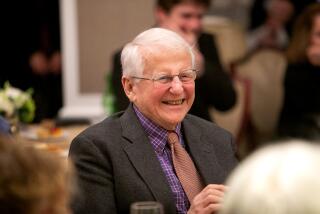How AproPoe
- Share via
Between the publication of his first book in 1827 and his death in 1849, Edgar Allan Poe wrote hundreds of short stories, poems, novellas, essays and literary critiques.
He virtually invented the detective story, revolutionized the short story, and his theories about the space-time continuum and the expanding and contracting universe predated those of Einstein and Stephen Hawking.
Yet during his life, his work was largely dismissed by his peers, and for years after he died, academics considered him something of an embarrassment. Even today he is commonly perceived as little more than a purveyor of spooky tales and darkly melodramatic poetry.
But quoth John Astin, “Nevermore.”
The 69-year-old actor, famous for his portrayal of Gomez Addams on the 1960s TV series “The Addams Family,” seeks to set the record straight with his one-man show, “Edgar Allan Poe--Once Upon a Midnight,” which he’ll present Saturday at Anaheim’s Pearson Park Amphitheatre.
“He was America’s first authentic genius,” Astin said recently by phone from his home in Brentwood. “Poe was such a mystical creature, but beyond that, he had these amazing insights into human nature and the nature of the universe.”
The two-hour play, written in 1994 by Paul Day Clemens and Ron Magid, finds Poe returning to present-day Earth to defend his legacy.
It relates Poe’s tragic life story, including his abandonment by his father and the death of his mother when he was 3, his abusive foster father, his struggle with alcoholism and poverty, the loss of his young wife to tuberculosis, and the events leading to his mysterious death.
Along the way, Astin intertwines passages from “The Tell-Tale Heart,” “Anabelle Lee,” “The Black Cat,” “The Haunted Palace” and more than 40 other stories, poems and nonfiction pieces--including a full reading of “The Raven.”
x
“In a sense, you experience his life and his death and you see how his life is reflected in his work and vice-versa,” Astin said. “It’s a fascinating approach.”
Although he’s only been portraying Poe since 1995, Astin said, he’s been a fan of the author’s brooding tales since reading “The Purloined Letter” as a boy.
While doing graduate studies in English at the University of Minnesota, Astin was dismayed at his teachers’ and fellow students’ low opinion of Poe.
The proof of Poe’s genius, Astin said, is his little-known book “Eureka: A Prose Poem,” in which he offers the first scientifically correct solution to the riddle of why the night sky is dark and presents the idea of the time-space continuum half a century before Einstein.
The 1848 work, Astin said, also puts forth concepts of an expanding and contracting universe, and a proposition similar to chaos theory, years ahead of modern theorists.
“ ‘Eureka’ was Poe’s masterwork,” Astin said. “It’s not like anything else he wrote. It’s a combination of science and spirituality. But beyond that it’s a work of art, and that’s how he wanted it to be perceived.”
“What he was trying to relate is the true nature of life and I think Poe would say that the only way you could do that is through art,” he said.
Still, Poe remains best known for his spooky and often violent tales of murder, madness, sickness and death--themes that might make a parent’s heart skip a telltale beat when kids discover Poe on the library bookshelf.
Astin says parents shouldn’t worry.
“Violence exists in life and most of our great literature deals with violence,” he said. “It’s how it’s dealt with that matters.
“When violence is gratuitous and the underlying theme of the work is that life doesn’t mean anything, then we have problems,” he said. “But if you have a work that is life-affirming, then it is meaningful. . . .
“Even though he probes into the darkness of the human condition, Poe’s ultimate message is life-affirming. And I think that makes a difference.”
Astin enjoys the irony in the same actor playing Poe and Gomez Addams and said he views them as two sides of the same coin.
“It’s interesting to draw parallels between Gomez and Poe. Each of them was fascinated by the nature of life,” he said. “But where Poe was interested in the exploration of life, Gomez is dedicated to its enjoyment.”
While the role of Poe may seem to be tailor-made for Astin (his resemblance in makeup to photographs of the author is uncanny), the play was not written for him.
“A few years back I thought, ‘Why not use what notoriety I have to do something I really care about?’ I wanted to do a one-person show and was researching a number of writers and historical figures, but Poe was at the top of my list,” he said. “One day I ran into Paul Clemens and he presented the play to me, and we’ve been together ever since.”
Although Clemens had been performing earlier versions of the play, Astin was the first to do it in its present form, which includes a recorded musical score, atmospheric lighting effects and screen projections.
He first staged it in Des Moines, to a sold-out audience and good reviews.
Encouraged, Astin and Clemens expanded the show with lighting effects and music and took it to Sarasota, N.Y., for a four-week run. Since then Astin has toured throughout the Midwest and Eastern and Southern states.
Saturday’s performance is the first time it has been presented outdoors.
“It’s an ideal setting for some of the ideas in the play,” Astin said. “Poe looked at life and death squarely, eye to eye, and I think those themes are going to sit well in an outdoor atmosphere.
“Whatever I can do to enhance the position and respect of this true genius, that’s my mission,” he said. “If people see this play and go out and read some Poe, that’s my reward.”
BE THERE
John Astin stars in “Edgar Allan Poe--Once Upon a Midnight,” Saturday at Pearson Park Amphitheatre, Lemon and Sycamore streets, Anaheim. 8 p.m. $5. Not recommended for children under 11. (714) 765-5274.
(BEGIN TEXT OF INFOBOX / INFOGRAPHIC)
A TIME LINE OF MAJOR EVENTS IN POE’S LIFE:
1809: Born in Boston, the son of traveling actors; father would later desert family
1811: Poe’s mother dies; he becomes ward of John Allan, a wealthy merchant from Richmond
1815-1820: Lives in England with the Allan family
1826: Enrolls in the University of Virginia; acquires gambling debts that John Allan refuses to pay. Eventually forced to leave the university
1827: Enlists in the army; publishes first book, “Tamerlane and Other Poems, By a Bostonian”
1829: Publishes second volume of poetry, “Al, Aaraaf, Tamerlane, and Minor Poems”
1830: Enters U.S. Military Academy at West Point
1831: Expelled from West Point for neglecting his duties
1831-36: Publishes the poems “To Helen” and “Israfel”; publishes a series of tales throughout the early 1830s while living with his aunt, Maria Clemm, and her daughter, Virginia;works for the Southern Literary Messenger writing reviews, original and revised poems and stories, including “The Narrative of Arthur Gordon Pym”
1836: Marries his 13-year-old cousin, Virginia Clemm
1839: Publishes “Tales of the Grotesque and Arabesque,” which contain several of his finest tales, including “Ligeia,” “The Fall of the House of Usher” and “William Wilson”
1841: Becomes editor of Graham’s Magazine, to which he contributed “The Murders in the Rue Morgue,” considered the blueprint for the modern detective story
1843: Receives greater recognition by releasing the prize winning story, “The Gold Bug” in Philadelphia’s Dollar Newspaper; also publishes “The Tell-Tale Heart” and “The Black Cat”
1845: Publishes two more collections of stories, “Tales’ and “The Raven and Other Poems” which bring him fame; antagonizes many when he publicly accuses poet Henry Wadsworth Longfellow of plagiarism; criticized for appearing drunk at public appearance in Boston
1846: Suffers economic hardship and ill health; publishes “The Cask of Amontillado” and “The Philosophy of Composition”
1847: Wife Virginia Poe dies of tuberculosis after five years of illness
1848: Supports himself as a lecturer. Expands his lecture on “The Universe” into his masterwork, “Eureka: A Prose Poem,” which explores the mysteries of the universe
1849: Becomes engaged to his childhood sweetheart, the widowed Sarah Elmira Royster Shelton; boards a steamer for Baltimore and disappears for five days; on Oct. 3, he is discovered nearly comatose outside a Baltimore saloon and polling place; dies four days later at the age of 40; cause of death is listed as “congestion of the brain,” though exact cause of death remains a mystery
Source: World Book Encyclopedia
More to Read
Sign up for our Book Club newsletter
Get the latest news, events and more from the Los Angeles Times Book Club, and help us get L.A. reading and talking.
You may occasionally receive promotional content from the Los Angeles Times.










